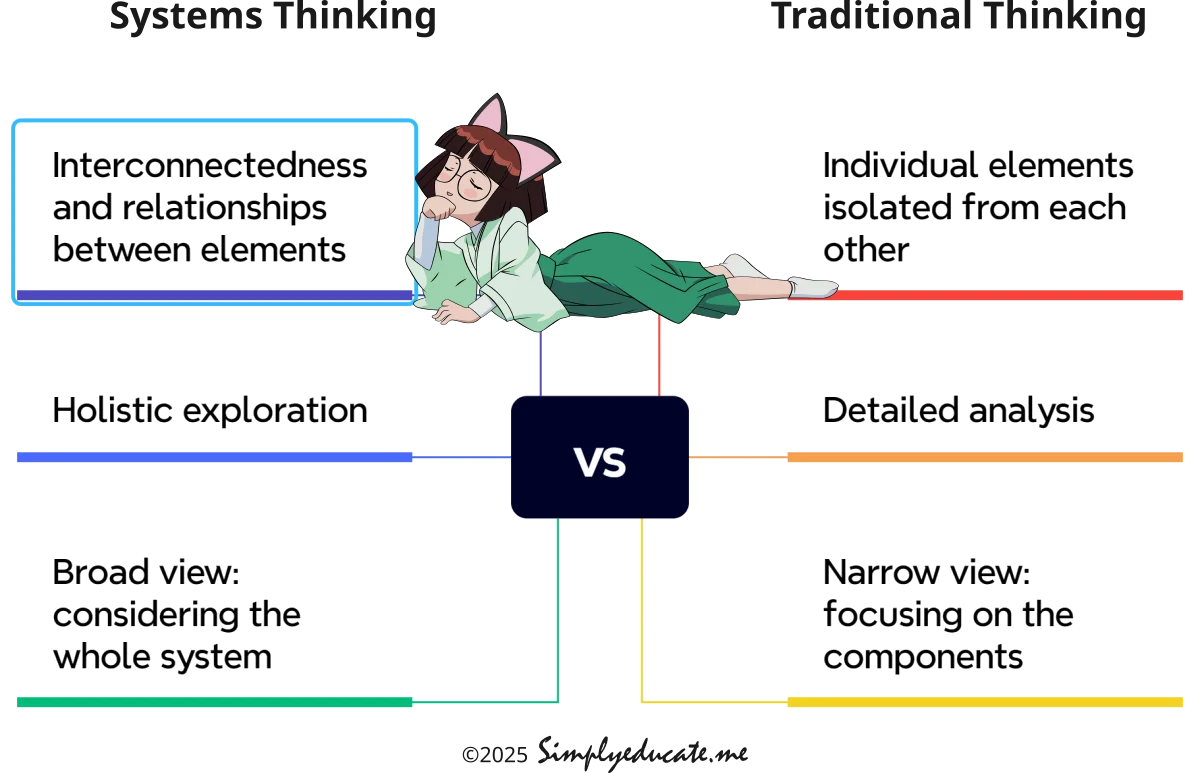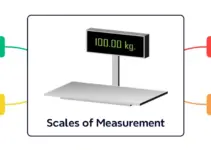Updated September 18, 2025

What is systems thinking? What are the techniques employed by systems thinking and what benefits can be gained from this thinking approach? In this article I will explain systems thinking recognizing the apparent scarcity of resources about the subject.
In an increasingly interconnected world, our conventional way of thinking often falls short in understanding and addressing the complex problems we face. Linear thinking, which relies on direct cause-effect relationships, is ill-equipped to navigate the intricate web of relationships that define our reality, be it biological, social, or technological. This is where Systems Thinking, a fundamentally different approach to problem-solving, comes into play.
Emphasizing a holistic view, Systems Thinking allows us to delve deep into the nuances of various systems in society, the environment, and beyond, offering profound insights that conventional modes often miss. In this inquiry into Systems Thinking, we will explore its principles, applications, critiques, and future possibilities.
Table of Contents
Fundamentals of Systems Thinking
What is Systems Thinking?
Systems Thinking is a way of understanding the world that focuses on seeing the bigger picture and how all parts are connected, rather than just analyzing each part separately. It emphasizes the importance of understanding the context and relationships within a system, which is becoming increasingly important in our complex world.
Systems Thinking is a way of understanding the world that focuses on seeing the bigger picture and how all parts are connected, rather than just analyzing each part separately.
At its core, traditional thinking often takes a reductionist approach, dissecting a problem into individual components to better understand them. Breaking down complex structures into manageable units has been crucial in understanding biological functions, chemical reactions, and physical phenomena.
However, this picture may exclude vital information, inadvertently neglecting the whole for the parts.
Enter Systems Thinking, a broader lens, encompassing the complexity and integration of various elements within a system. Here, the focus is not merely on discrete components but on the relationships and interactions between them.
Looking closely at this intricate web of connections offers valuable insights into how the whole operates cohesively. From ecosystems to human societies, this holistic perspective frames phenomena as dynamic, multifaceted systems.
The following table shows the difference between systems thinking and traditional thinking based on seven aspects.
| Aspect | Systems Thinking | Traditional Thinking |
|---|---|---|
| 1. Focus | Interconnectedness and relationships | Individual elements |
| 2. Approach | Holistic exploration | Detailed analysis |
| 3. Perspective | Broad view considering the whole system | Narrow view focusing on parts |
| 4. Importance of Context | High – values understanding the broader context | Low – primarily concerned with specific details |
| 5. Application | Useful in complex, evolving situations | Effective in well-defined, static situations |
| 6. Problem Solving | Emphasizes identifying patterns and integrating solutions holistically | Focuses on breaking problems into parts and solving them individually |
| 7. Outlook | Dynamic and adaptive | Linear and more static |
Emergent Properties of Systems in Combination
The essence is embodied by the phrase “the whole is greater than the sum of its parts.” A system is viewed not just as an amalgamation of its constituents, but an entity characterized by emergent properties – qualities that materialize only when the elements interact.
In an ecosystem, for instance, species, weather patterns, geography, and biology interweave to form intricate networks of relationships dictating the ecosystem’s overall health and vitality. Analyzing these individual parts can provide rich insights, but discerning the emergent properties of the system is where Systems Thinking truly shines.
Integration of Systems Thinking in Various Fields
The principles of Systems Thinking have been incorporated in fields as diverse as management studies, computer science, and urban planning. By focusing on understanding, predicting, and ideally, enhancing the overall performance of a system, it becomes an indispensable tool in creating efficient, sustainable, and resilient systems, whether ecological, organizational, or computational.
This shift in thinking is not without challenges. The sheer complexity and dynamism of systems can be daunting, necessitating advanced computational tools, vast data sets, and significant expertise.
Furthermore, rendering accurate predictions within systems often proves elusive, due to the multitude of interacting variables and the unpredictable nature of emergent properties. However, these challenges underscore the importance of this approach, highlighting the necessity for sophisticated methods capable of untangling this complexity, and thus progressing towards a deeper understanding of our world.
Systems Thinking offers an intricate, interconnected perspective, distinguished from the reductionism of traditional thinking. Emphasizing complex relationships and emergent properties, it provides a comprehensive lens through which to view, and perhaps more importantly, to understand, the complex systems.

Techniques of Systems Thinking
To make Systems Thinking practical, educators, researchers, and practitioners often use specific tools that help them analyze complexity, visualize relationships, and anticipate possible outcomes. Below are five commonly used techniques:
1. Causal Loop Diagrams
Causal loop diagrams (CLDs) illustrate cause–effect relationships among variables. They highlight reinforcing loops (where actions amplify outcomes) and balancing loops (where actions stabilize systems).
For example, in environmental management, overfishing reduces fish populations, which in turn reduces fishing yields—a balancing loop that can stabilize at a lower equilibrium or collapse the system if unchecked.
2. Stock and Flow Diagrams
Stock and flow diagrams represent the “stocks” (resources or accumulations, such as water in a reservoir) and the “flows” (inflows and outflows, such as rainfall or water use) that affect them over time. These diagrams help model dynamic changes, such as population growth, energy use, or capital investment, and are often used in system dynamics simulations.
3. Systems Mapping
Systems mapping provides a visual overview of how different elements in a system connect. It can show stakeholders, resources, information flows, or environmental factors. By laying out these interconnections, systems maps reveal leverage points for intervention, bottlenecks, or unintended consequences of actions.
4. Scenario Planning
Scenario planning is a technique for exploring alternative futures by considering different assumptions, trends, and uncertainties. In systems thinking, it helps organizations and policymakers imagine possible system behaviors under changing conditions, such as climate change, technological disruption, or economic shifts. This prepares decision-makers for a range of potential outcomes rather than a single forecast.
5. Soft Systems Methodology (SSM)
Soft Systems Methodology is especially useful for ill-structured, human-centered problems where there is no single “correct” solution. Instead of focusing only on quantitative data, SSM uses conceptual models, stakeholder perspectives, and iterative discussions to build shared understanding and practical strategies. It is widely applied in organizational change, policy analysis, and community development.
Applications of Systems Oriented Thinking
Systems-oriented thinking, by its very nature, is a versatile and effective paradigm that finds utility in multiple domains. Whether it is the intricate workings within a biological organism, the interplay of factors in an ecosystem, or the countless variables in a socio-economic structure, the systems perspective offers a lens that prompts us to think beyond isolated elements and towards interconnected components in a complex network. One could even extend this philosophy to areas such as artificial intelligence, where it helps in understanding and designing complex neural networks.
1. Helps understand complexity
One of the foremost strengths of systems-oriented thinking lies in its multidirectionality. Instead of the linear, cause-effect relationship seen in reductionist thinking, the systems perspective acknowledges that the components of a system influence each other in myriad ways – forming loops of dependencies, feedback mechanisms, and intricate interdependencies. It acknowledges the dynamic nature of real-world systems, helping us appreciate the world’s complexity in a wholistic manner.
2. Brings together knowledge from various disciplines
A second, equally significant strength of systems-oriented thinking is its inherent adaptability. When applied to different domains, the fundamental tenets of the technique remain the same – understanding the system’s structure, identifying the components and their interactions, and analyzing how the system evolves over time. Yet, the specifics of the application can vary immensely, leading to a framework that is as versatile as it is exacting.
When employed in the natural sciences, for example, systems thinking brings together knowledge from various disciplines – genetics, biochemistry, physiology, and more – to understand the complex transdisciplinary networks within organisms or ecosystems.
In social sciences, it aids in identifying the interplay among social, economic, political, and cultural factors that shape societies. In business and administration, it guides strategic planning, focusing on the entirety of a situation rather than isolated components.
Challenges of Systems Thinking
One cannot overlook the challenges and limitations inherent in this technique. The difficulty in defining system boundaries, the profound complexity of real-world systems, and the potential for failing to see the smaller details amidst the broader perspective are some of the challenges that researchers must face. Nevertheless, in our increasingly interconnected and globalized world, the systemic perspective’s relevance and importance have only grown.
The beauty of systems-oriented thinking lies in its depth and breadth, which lends it the ability to synthesize knowledge across disciplines, offering new insights and fostering creative solutions.
Limitations of Systems Oriented Thinking
1. Too abstract and lacks precision
Critics of the systems perspective often argue that it is too abstract and lacks precision. They comment that the systems approach can sometimes overlook important details; primarily due to its overarching focus on the broad interrelations and interactions between components.
While traditional scientific approach targets specificity, sharpness and detail, Systems Thinking prefers a generalized, high-level perspective which may sometimes miss depth in understanding a single unit or component.
2. Applicability and relevance in real-world applications
Moreover, the contention arises in terms of applicability and relevance. Critics question whether systems thinking, with its broad and generalized structure, can mirror the complexity of real-world applications. Particularly in domains where the chaotic nature and unpredictable variables do not lend themselves to systematic and interrelated interpretations.
3. Practicality of using systems thinking
Another criticism lies in the challenge of translating the theory of systems thinking into practical use. Implementation often proves to be strenuous and replete with obstacles due to the inherent intricate complexity of the systems themselves.
In domains like business and administration, the complexity might bar a successful execution of this thinking. Following a systems approach would imply dealing with the organization as a whole, rather than specific departments or functions, thereby making changes logistically challenging and operationally complex.
Moreover, a lack of mathematical rigor and empirical strength can be mentioned when discussing the constraints of Systems Thinking. Critics further note that extensive reliance on qualitative information may deter empirical verifiability and lead to abstractions of actual real-world situations.
However, it is important to understand these criticisms within the larger context. Systems Thinking isn’t a panacea for all domains or situations, instead, it’s a methodological approach for understanding multifaceted phenomena. While it may entail limitations, this doesn’t invalidate its utility.
The beauty of Systems Thinking is in its encompassing view, permitting an appreciation of the system as an entity rather than the summation of the individual parts. Thus, while the criticisms hold their ground and require resolution, they should not forget the intellectual power and potential this approach delivers in understanding our interrelated and interconnected world. It fuels humanity’s quest for knowledge and its application for societal progress.
The Future of Systems Oriented Thinking
As we consider the future prospects of Systems Oriented Thinking, two pivotal aspects are paramount: constantly evolving technologies and emerging global issues. This advanced approach – encompassing multifaceted systems thinking – is well-poised to adapt to the complexities of the technological arena, while addressing large-scale global challenges with an eye for greater harmony, balance, and sustainability.
Trending technologies such as Artificial Intelligence (AI) and advanced data analytics are fundamentally altering how we perceive, assimilate, and interact with complex information systems. Harnessing this potential, Systems Thinking could employ AI to model complex systems more effectively and facilitate informed decision-making. From climate modeling to bioinformatics, AI is rapidly becoming an invaluable tool to visualize and comprehend vast, interlinked data sets, a territory where Systems Thinking truly thrives.

Simultaneously, the rise of network science and AI enables novel explorations into how systems evolve and adapt, thereby extending the effectiveness of Systems Thinking. Tools like AI and neural networks are already reshaping our comprehension of complex areas such as neuroscience and social dynamics, allowing for a more profound analysis and reflection of emergent properties.
Global challenges, ranging from climate change to socio-economic disparities, mandate an all-encompassing approach to ensure meaningful and lasting solutions. The interconnectedness inherent within these issues lends itself to the purview of Systems Oriented Thinking. By viewing these multifaceted problems through a systems-based perspective, we heighten the possibility of identifying holistic and sustainable solutions.
For instance, the fight against global climate change necessitates an understanding of intricate eco-system interactions, energy systems, and socio-political dynamics, among others. Utilizing Systems Thinking, researchers can develop integrated initiatives encompassing conservation strategies, renewable energy technologies, and global policy adaptations.
Ultimately, parallel to honing and refining Systems Thinking, efforts should bolster its translation into practical applications and decision-making processes. Given the evolving technologies and complex global issues, the capacity to retain a comprehensive, systems-level viewpoint supports our ability to generate balanced, effective, and sustainable solutions.
As we look to the future, the potential of Systems Thinking in shaping our society and the world at large becomes evident. This approach, far from being merely an academic exercise, holds the promise of reshaping how we view and address our most pressing global challenges, from pandemics to climate change. At the same time the advent of new technologies like AI and machine learning could bring about a revolution in Systems Oriented Thinking, pushing the boundaries of what we can understand and accomplish.
However, we must also be cognizant of its limitations and areas for improvement, ensuring that we draw upon a diverse range of strategies to complement the holistic view offered by Systems Thinking.
FAQ
Q1: What is Systems Thinking?
Systems Thinking is a holistic approach that examines how different parts of a system interact and influence one another. Unlike reductionist thinking, which isolates components, Systems Thinking focuses on interconnections, feedback loops, and emergent properties.
Q2: What are emergent properties in Systems Thinking?
Emergent properties are features or behaviors of a system that only appear when its parts interact as a whole. They cannot be explained by analyzing components in isolation. Examples include ecosystem stability, organizational culture, or traffic flow patterns.
Q3: What techniques are used in Systems Thinking?
Common techniques include:
- Causal Loop Diagrams – show feedback loops and cause–effect relationships.
- Stock and Flow Diagrams – represent resources and their changes over time.
- Systems Mapping – visualizes connections among variables or stakeholders.
- Scenario Planning – explores alternative futures based on system dynamics.
- Soft Systems Methodology (SSM) – applies systems thinking to ill-structured problems.
Q4: In which fields or contexts is Systems Thinking applied?
Systems Thinking is widely applied in ecology, business management, organizational development, urban planning, environmental science, education, health systems, and even artificial intelligence research. It is especially valuable in addressing “wicked problems” with complex interdependencies.
Q5: What are the challenges or limitations of Systems Thinking?
Limitations include difficulty in defining system boundaries, complexity of data requirements, potential over-abstraction, and challenges in practical implementation. It may also require interdisciplinary collaboration and advanced tools to apply effectively.
Q6: What benefits does Systems Thinking offer?
Benefits include deeper understanding of complex issues, recognition of feedback loops, improved problem-solving strategies, integration of diverse perspectives, and the ability to design sustainable, resilient, and adaptive systems.
Q7: Can you give examples of Systems Thinking in action?
Examples include:
- Ecosystem management – balancing species, resources, and climate factors.
- Business supply chains – optimizing production, logistics, and sustainability.
- Public health – analyzing spread of diseases, healthcare access, and social determinants.
- Urban planning – considering traffic flow, housing, and environmental impact together.



